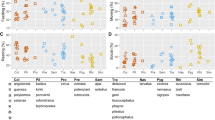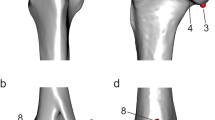Abstract
Evolutionary plasticity is limited, to a certain extent, by phylogenetic constraints. We asked whether the diel activity patterns of animals reflect their phylogenies by analyzing daily activity patterns in the order Rodentia. We carried out a literature survey of activity patterns of 700 species, placing each in an activity time category: diurnal, nocturnal, or active at both periods (a-rhythmic). The proportion of rodents active at these categories in the entire order, was compared to the activity patterns of species of different families for which we had data for over ten species each: Dipodidae, Echimyidae, Geomyidae, Heteromyidae, Muridae, and Sciuridae. Activity times of rodents from different habitat types were also compared to the ordinal activity time pattern. We also calculated the probability that two random species (from a particular subgroup: family, habitat, etc.) will be active in the same period of the day and compared it to this probability with species drawn from the entire order. Activity patterns at the family level were significantly different from the ordinal pattern, emphasizing the strong relationship between intra-family taxonomic affiliation and daily activity patterns. Large families (Muridae and Sciuridae) analyzed by subfamilies and tribes showed a similar but stronger pattern than that of the family level. Thus it is clear that phylogeny constrains the evolution of activity patterns in rodents, and may limit their ability to use the time niche axis for ecological separation. Rodents living in cold habitats differed significantly from the ordinal pattern, showing more diurnal and a-rhythmic activity patterns, possibly due to physiological constraints. Ground-dwelling rodents differed significantly, showing a high tendency towards a-rhythmic activity, perhaps reflecting their specialized habitat.
Similar content being viewed by others
References
MC Antle R Silver (2005) ArticleTitleOrchestrating time: arrangements of the brain circadian clock Trends Neurosci 28 145–151 Occurrence Handle15749168 Occurrence Handle1:CAS:528:DC%2BD2MXitVeis78%3D Occurrence Handle10.1016/j.tins.2005.01.003
MJ Benton (2000) Vertebrate palaeontology EditionNumber2 Blackwell Science Ltd Oxford, England
S Daan (1981) Adaptive daily strategies in behavior J Aschoff (Eds) Handbook of behavioral neurobiology 4: biological rhythms Plenum press New York and London 275–298
C Darwin (1859) On the origin of species by means of natural selection, or the preservation of favoured races in the struggle for life John Murray London
T Day PA Abrams JM Chase (2002) ArticleTitleThe role of size-specific predation in the evolution and diversification of prey life histories Evolution 56 877–887 Occurrence Handle12093024 Occurrence Handle10.1554/0014-3820(2002)056[0877:TROSSP]2.0.CO;2
Degen AA (1997) Ecophysiology of small desert mammals. In: Cloudsley-Thompson JL (ed), Springer, Berlin
PJ DeCoursey (2004) The behavioural ecology and evolution of biological timing systems JC Dunlap JJ Loros PJ DeCoursey (Eds) Chronobiology, biological timekeeping Sinauer Associates, Inc. Publishers Sunderland, Massachusetts 27–65
BD Goldman SL Goldman AP Riccio J Terkel (1997) ArticleTitleCircadian patterns of locomotor activity and body temperature in blind mole-rats, Spalax ehrenbergi J Biol Rhythm 12 348–361 Occurrence Handle1:STN:280:DyaK1c7gtFyltA%3D%3D Occurrence Handle10.1177/074873049701200407
SJ Gould RC Lewontin (1979) ArticleTitleThe spandrels of San Marco and the Panglossian paradigm Proc R Soc Lond B Bio 205 581–598 Occurrence Handle1:STN:280:Bi%2BD2sbovVU%3D Occurrence Handle10.1098/rspb.1979.0086
JL Hartenberger (1998) ArticleTitleDescription of the radiation of the Roentia (Mammalia) from the Late Paleocene to the Miocene; phylogenetic consequences C R Acad Sci II A 326 439–444
D Huchon O Madsen MJJB Sibbald K Ament MJ Stanhope F Catzeflis WW Jong Particlede EJP Douzery (2002) ArticleTitleRodent phylogeny and a timescale for the evolution of Glires: evidence from an extensive taxon sampling using three nuclear genes Mol Biol Evol 19 1053–1065 Occurrence Handle12082125 Occurrence Handle1:CAS:528:DC%2BD38Xlt1aktr0%3D
GH Jacobs (1993) ArticleTitleThe distribution and nature of color vision among the mammals Biol Rev Cambridge Philos Soc 68 413–471 Occurrence Handle1:STN:280:ByyA2M%2FgvFE%3D Occurrence Handle8347768 Occurrence Handle10.1111/j.1469-185X.1993.tb00738.x
N Kronfeld A Haim T Dayan N Zisapel M Klingenspor G Heldmaier (2000) ArticleTitleSeasonal thermogenic acclimation of diurnally and nocturnally active desert spiny mice Physiol Biochem Zool 73 37–44 Occurrence Handle10.1086/316718
N Kronfeld-Schor T Dayan R Elvert A Haim N Zisapel G Heldmaier (2001a) ArticleTitleOn the use of the time axis for ecological separation: diel rhythms as an evolutionary constraint Am Nat 158 451–457 Occurrence Handle10.1086/321991 Occurrence Handle1:STN:280:DC%2BD1crjsVSruw%3D%3D
N Kronfeld-Schor T Dayan ME Jones I Kremer Y Mandelik M Wollberg Y Yassur D Gaton (2001b) ArticleTitleRetinal structure and foraging microhabitat use of the golden spiny mouse J Mammal 82 1016–1025 Occurrence Handle10.1644/1545-1542(2001)082<1016:RSAFMU>2.0.CO;2
N Kronfeld-Schor T Dayan (2003) ArticleTitlePartitioning of time as an ecological resource Annu Rev Ecol Syst 34 153–181 Occurrence Handle10.1146/annurev.ecolsys.34.011802.132435
D Lack (1947) Darwin’s finches Cambridge University Press Cambridge, England
JH Lawton (1999) ArticleTitleAre there general laws in ecology? Oikos 84 177–192 Occurrence Handle10.2307/3546712
SL Lima LM Dill (1990) ArticleTitleBehavioral decisions made under the risk of predation: a review and prospectus Can J Zool 68 619–640 Occurrence Handle10.1139/z90-092
JB Losos M Leal RE Glor K Queiroz ParticleDe PE Hertz LR Schettino AC Lara TR Jackman A Larson (2003) ArticleTitleNiche lability in the evolution of a Caribbean lizard community Nature 424 542–545 Occurrence Handle12891355 Occurrence Handle1:CAS:528:DC%2BD3sXlvVGis7o%3D Occurrence Handle10.1038/nature01814
D Morris (1965) The mammals, a guide to living species Hodder and Stoughton Great Britain
RM Nowak (1999) Walker's Mammals of the World EditionNumber6 John Hopkins University Press Baltimore, Maryland
H Oster A Avivi A Joel (2002) ArticleTitleA switch from diurnal to nocturnal activity in S. ehrenbergi is accompanied by an uncoupling of light input and the circadian clock Curr Biol 12 1919–1922 Occurrence Handle12445384 Occurrence Handle1:CAS:528:DC%2BD38XovFCitb4%3D Occurrence Handle10.1016/S0960-9822(02)01263-0
ER Pianka LJ Vitt (2003) Lizards University of California Press Berkeley and Los Angeles, California
AP Riccio BU Goldman (2000) ArticleTitleCircadian rhythms of locomotor activity in naked-mole-rats (Heterocephalus glaber) Physiol Behav 71 1–13 Occurrence Handle11134679 Occurrence Handle1:CAS:528:DC%2BD3cXovFKjsbk%3D Occurrence Handle10.1016/S0031-9384(00)00281-X
SA Richards (2002) ArticleTitleTemporal partitioning and aggression among foragers; modelling the effects of stochasticity and individual state Behav Ecol 13 427–438 Occurrence Handle10.1093/beheco/13.3.427
CB Saper TE Scammell J Lu (2005) ArticleTitleHypothalamic regulation of sleep and circadian rhythms Nature 437 1257–1263 Occurrence Handle16251950 Occurrence Handle1:CAS:528:DC%2BD2MXhtFCrurrP Occurrence Handle10.1038/nature04284
CB Saper J Lu TC Chou J Gooley (2005) ArticleTitleThe hypothalamic integrator for circadian rhythms Trends Neurosci 28 142–157 Occurrence Handle10.1016/j.tins.2004.12.009 Occurrence Handle1:CAS:528:DC%2BD2MXitVeis7o%3D
TW Schoener (1974a) ArticleTitleResource partitioning in ecological communities Science 185 27–38 Occurrence Handle10.1126/science.185.4145.27
TW Schoener (1974b) ArticleTitleThe compression hypothesis and temporal resource partitioning Proc Natl Acad Sci USA 71 4169–4172 Occurrence Handle10.1073/pnas.71.10.4169
D Simberloff (2004) ArticleTitleCommunity ecology: is it time to move on? Am Nat 163 787–799 Occurrence Handle15266378 Occurrence Handle10.1086/420777
L Smale T Lee AA Nunez (2003) ArticleTitleMammalian diurnality: some facts and gaps J Biol Rhythm 18 356–366 Occurrence Handle10.1177/0748730403256651
I Tattersall (1988) ArticleTitleCathemeral activity in primates: a definition Folia Primatol 49 200–202 Occurrence Handle10.1159/000156323
CO Webb DD Ackerly MA McPeek MJ Donoghue (2002) ArticleTitlePhylogenies and community ecology Annu Rev Ecol Syst 33 475–505 Occurrence Handle10.1146/annurev.ecolsys.33.010802.150448
Weinstein M (2003) Spiny arthropods, spiny parasites and spiny mice—availability and ecology in En Gedi. M.Sc. dissertation, Tel Aviv University, Israel (in Hebrew)
JA Weins JF Addicot TJ Case J Diamond (1986) Overview: the importance of spatial and temporal scale in ecological investigation J Diamond TJ Case (Eds) Community ecology Harper and Row New York 145–153
P Willmer G Stone I Johnston (2000) Environmental physiology of animals Blackwell Science Ltd Paris, France
DE Wilson DM Reeder (1993) Mammal species of the world EditionNumber2 Smithsonian Institution Press Washington DC
KV Young ED Brodie SuffixJr ED Brodie (2005) ArticleTitleHow the horned lizard got its horns Science 304 65 Occurrence Handle10.1126/science.1094790
Author information
Authors and Affiliations
Corresponding author
Electronic supplementary material
Rights and permissions
About this article
Cite this article
Roll, U., Dayan, T. & Kronfeld-Schor, N. On the role of phylogeny in determining activity patterns of rodents. Evol Ecol 20, 479–490 (2006). https://doi.org/10.1007/s10682-006-0015-y
Received:
Accepted:
Issue Date:
DOI: https://doi.org/10.1007/s10682-006-0015-y




